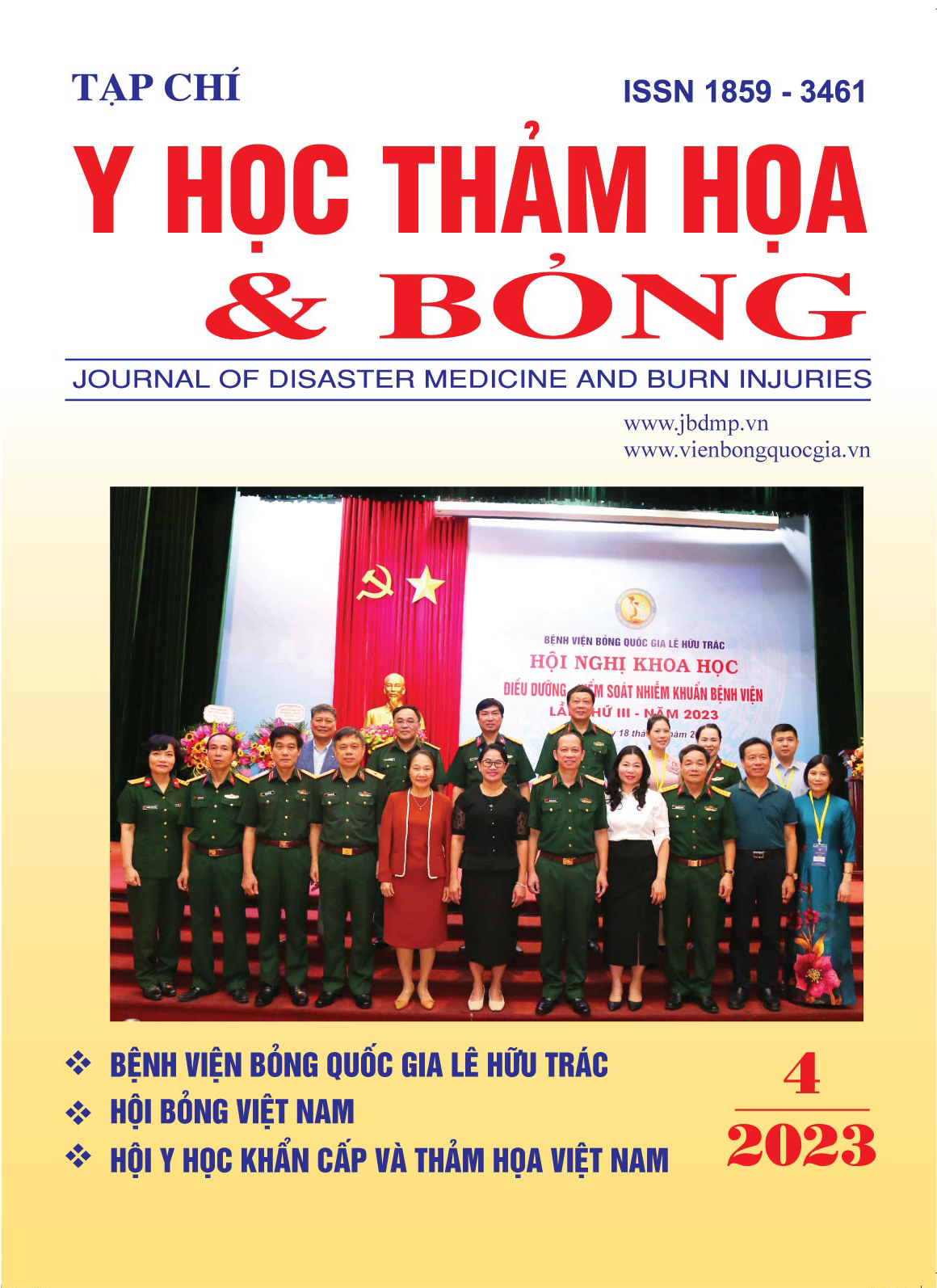Assessment of practice of standard infection control precautions among healthcare workers at the Le Huu Trac National Burn Hospital
Main Article Content
Abstract
Objective: To assess the practice of standard infection control precautions among healthcare workers at Le Huu Trac National Burn Hospital.
Subjects and Methods: Health care workers including doctors, nurses and trainees of clinical departments from July 2022 to April 2023. Prospective, descriptive observation study on the practice of hand washing, sterilization and sterilization of medical instruments in clinical departments.
Results: 1/Proportion of hand hygiene of medical staff: Trainees 21.1%, Doctors 36.7%, Nurses 38.6% and only 22.5% complied with all 6 steps of hand hygiene. Through two methods of monitoring surgical hand hygiene, the compliance rate observed directly at 45.3% was higher than that observed through the camera at 25.1%. The rate of positive samples in the hands of medical staff was 21.6%.
2/ Practical skills of the sterilization-sterilization process: The ratio of mixing chemicals with the correct concentration and soaking time for full sterilization was only 70%, the preparation of preliminarily disinfecting chemicals with the correct concentration only reached 51.7% and the tools after use were submerged only 58.3%. All other contents are above 80%. There were 8/30 samples of semi-essential medical equipment contaminated with bacteria (26.7%). The bacterial species isolated were mainly Bacillus (75.0%).
Conclusion: Compliance with some infection control procedures by medical staff in clinical departments of Le Huu Trac National Burn Hospital has still not been high.
Article Details
Keywords
Infection control, healthcare workers
References
2. Bộ Y tế (2018), Quy định về kiểm soát nhiễm khuẩn trong các cơ sở khám bệnh, chữa bệnh. TT 16/2018/TT-BYT.
3. Nguyễn Thị Hương & cộng sự (2016). “Nghiên cứu thực trạng và hiệu quả của các biện pháp can thiệp nhằm nâng cao kiến thức, kỹ năng thực hành vệ sinh bàn tay của nhân viện y tế Viện Bỏng Quốc gia”, Tạp chí Y học Thảm họa và Bỏng,(4) tr 32- 40.
4. Trần Hữu Luyện, Đặng Như Phồn (2010), “Khảo sát tuân thủ vệ sinh tay tại bệnh viện TW Huế theo lời kêu gọi của Tổ chức Y tế Thế giới nhân ngày 5-5-2010”, Tạp chí Y học lâm sàng, NXB Đại học Huế, tr 19-23.
5. Đặng thị Thu Hương và cs (2022), ”Tỷ lệ tuân thủ vệ sinh tay của Nhân viên y tế tại Bệnh viện nhi Trung ương qua giám sát giai đoạn từ 2012-2015”, Báo cáo tại Hội nghị Khoa học chuyên nghành KSNK -Bệnh viện Quân y 103 -HVQY 2016.
6. Nguyễn Văn Quang (2014),” Khảo sát tỷ lệ tuân thủ vệ sinh tay tại Bệnh viện Quân y 175” Kỷ yếu Hội nghị khoa học điều dưỡng toàn quân 2014. Tr 125-129.
7. CDC (2009),wash your hands http://www.cdc.gov/featurs/hand wwashing/16/4/2014.
8. Pitted D (2000), lancet 2000:356;1307-1312.
9. Nguyễn Văn Hoàn (2017) “Đánh giá việc tuân thủ quy trình rửa tay phẫu thuật của Bác sĩ phẫu thuật viên, điều dưỡng viên tại phòng mổ, Bệnh viện Quân y 110”. Kỷ yếu Hội nghị khoa học điều dưỡng toàn quân 2017, tr 2016-2019.
10. Denis G. Maki, Paul A. Tambyah (Mar.Apr 2001) "Enineering out the risk of infection with urinary catherter uni.of Wiscousin medical Scool." Emerging Infections diseases,7.
11. Lương Đình Tuân (2020), “Đánh giá kiến thức, thực hành của điều dưỡng về xử lý dụng cụ y tế tái sử dụng năm 2020" Báo cáo tại Hội nghị Khoa học điều dưỡng - Bệnh viện Bỏng Quốc gia Lê Hữu Trác-2020.


